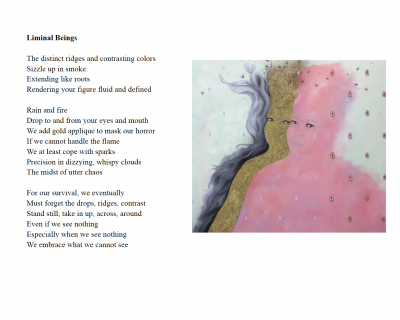Queer Muslim Environmentalisms in the United States

This summer, I pursued a project on queer Muslim environmentalisms in the United States, which I hope to develop into an honors thesis with the International Comparative Studies program at Duke. My main questions for this project are as follows: (1) How do Muslim and queer environmentalisms connect? (2) How can the intersection of queer and Muslim perspectives shift Anglo-Western dominated environmental discourse? (3) How is this reflected in the lives and expressions of queer Muslims within the United States? I developed an interest in this topic after realizing that my identities as queer and Muslim greatly strengthened my commitment to the environment. My queerness and Muslimness motivate my search for an understanding of nature and the environment beyond Anglo-Western accounts, which are often dominated by capitalism, heteropatriarchy, and human exceptionalism. The Anglo-Western consideration of nature as objective and stagnant, at the mercy of human domination, is present in mainstream environmentalist movements and supports “the very relations of power that produce environmental problems” (Whitworth, 2018, 74–75). To unlearn these power relations, I look to new paradigms to restructure the way I think about the environment. Although I have much more to explore, I find that putting queerness and Muslimness in dialogue could open new possibilities for understanding the environment.
To address my questions, I first situated queer Muslim politics within my thesis by analyzing the interactions between white settler colonization, homocolonialism, and Islamic fundamentalism. I then applied the analysis to envision the potential of queer Muslims in environmental discourse. This formed the first chapter of my thesis. Additionally, I searched for connections in leading literature on Muslim environmentalisms and queer environmentalisms, keeping in mind that “queer” and “Muslim” encompass robust, pluralistic frameworks. The foray I take into these connections will constitute the second chapter of my thesis. Finally, I focused on the perspectives of leading queer Muslim figures in the United States, which will become the third thesis chapter. This summer, I explored environmental motifs in Saba Taj’s there are gardens at the margins, a mixed media visual art exhibition highlighting queer Muslims. After observing the exhibition, displayed online and at the Duke University Nasher Museum, I wrote reflective poetry about the pieces.
My research process so far has brought me healing; I finally could put language to my experiences as a queer Muslim. Before I could talk about environmentalism specifically, I had to reckon with the perceived contradiction in my identity. How can I be both queer and Muslim, especially if Muslims are seen as heterosexist and regressive in contrast to the more queer-affirming, progressive West? In my work this summer, I demonstrated how this dichotomy developed due to the rise of homonationalism in the West, and by extension homocolonialism, coupling with the development of Islamic fundamentalism to ideologically oppose one another. In the Oriental Islam-West dichotomy, queer Muslims are treated as objects, perceived by others but grossly underrepresented as voices. For this thesis, I intend to take the focus off queer Muslims as objects and instead center their perspectives on an important topic, such as environmentalism. Through an intersectional queer Muslim perspective, my intention is to find a comprehensive environmentalism, one that accounts for homocolonialism, Orientalism, and heteropatriarchy but is not defined solely by relationships with systemic oppression.
Although there is nearly no literature on queer Muslim environmentalisms specifically, an abundance of literature on queer environmentalisms and Muslim environmentalisms exists separately. Despite the reality that scholarship in queer and Muslim environmentalisms has also been impacted by homocolonialism and Orientalism (as with nearly every aspect of society), these rich perspectives share commonalities and points of solidarity. Prominent literature in queer and Muslim environmentalisms challenge anthropocentrism, embody humorous and satirical tones, find comfort in contradiction, disrupt conceptions of time as linear, create relationships with the environment beyond a problem to be solved, and see humans and nature as intrinsically linked. These similarities all in some way resist white settler-colonial, heteronormative environmental discourse.
While drawing connections between queer environmentalisms and Muslim environmentalisms separately could hint at the potential of queer Muslim environmentalisms, interacting with the lives and expressions of queer Muslims themselves provides the best insight into their relationship with the environment. As demonstrative of Kimberle Crenshaw’s writings on intersectionality, queer Muslim environmentalisms as an intersectional perspective is not merely the summation or overlap of queer environmentalisms and Muslim enviornmentalisms. Rather, it is a unique perspective truly understood by the people who experience both of these identities.
To capture genuine expressions of queer Muslim environmentalisms, I analyzed and wrote poetry on Saba Taj’s there are gardens at the margins, a mixed-media exhibit highlighting queer Muslims in the American South. In an interview with The Georgia Review, Saba Taj talks discusses her intentional concealment of the people she paints, protecting them and asserting that they do not have to prove themselves to outsiders. The subjects make eye contact with the viewers, positioning them as the perceiving rather than the perceived. Taj also incorporates themes of Barzakh in the paintings, a Qur’anic theme of paradoxical connection within boundaries. Barzakh can be represented as the meeting between freshwater and saltwater, between the material and spiritual world, a rainbow between two clouds, or the duality of light as particles and waves. Saba Taj employed this concept as a symbol for how queer Muslims blur gender boundaries through their very existence. In my reflective poetry, I marveled at the contradiction within Barzakh, feeling humbled by the infinities of nature beyond my comprehension. I also included certain aspects of the paintings– bees, mirage, shadows, smoke, and gardens– as environmental motifs in the poems.
In the next school year, I plan to complete my thesis by revising my first chapter on the politics of queer Muslims, writing a chapter on the connections between queer and Muslim environmentalisms, and interviewing more queer Muslims about their relationships with the environment. I am grateful to the Deans Summer Research Fellowship for their support in this project.



